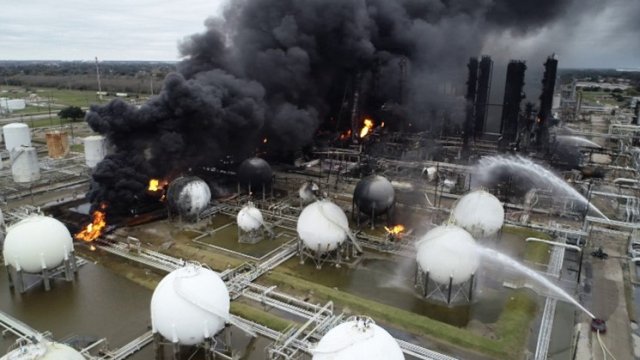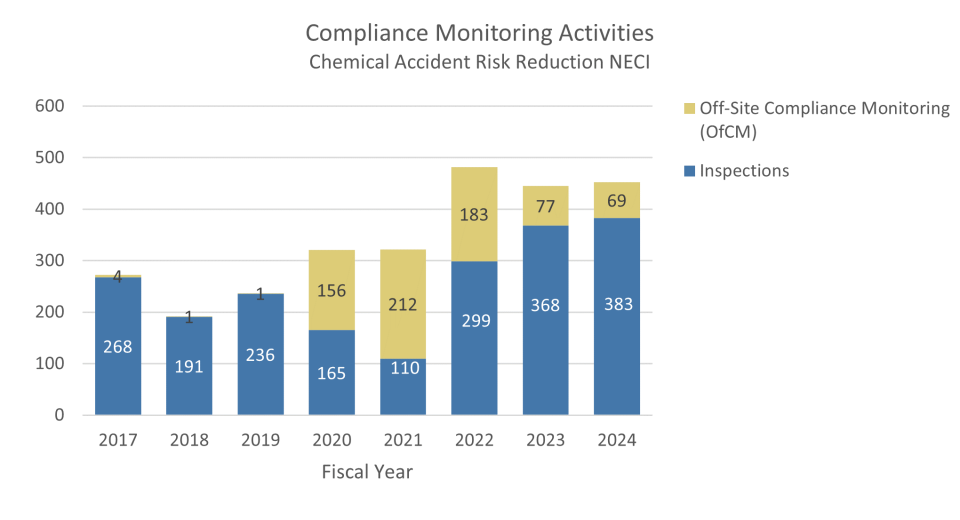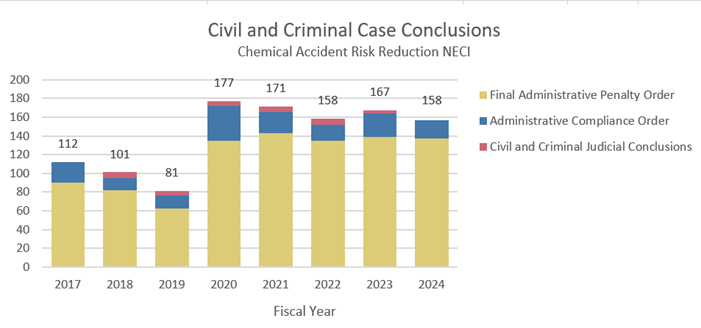National Enforcement and Compliance Initiative: Chemical Accident Risk Reduction
Problem

Thousands of facilities nationwide, make, use, or store extremely hazardous substances. Clean Air Act section 112(r) requires such facilities to implement programs to manage the risks posed by their operations. Failure to do so can result in catastrophic accidents that cause serious injuries and fatalities, evacuations, and shelter-in-place orders. Major chemical accidents continue to occur at facilities that are not adequately managing risk. It is critical to address the significant Clean Air Act section 112(r) non-compliance observed throughout the country to ensure the safety of workers, first responders, and surrounding communities, many of which are already overburdened by pollution, face climate change related hazards or both.
Goals
Launched in 2017, this Chemical Accident Risk Reduction National Enforcement and Compliance Initiative or NECI seeks to reduce risks to human health and the environment by decreasing the likelihood of chemical accidents. This will be achieved by addressing significant noncompliance with the general duty to maintain a safe environment and risk management plan rules. Given the importance of this work, EPA has renewed this NECI for a third cycle, which runs from fiscal years (FY) 2024-2027.
While all chemical accident risk reduction activities will continue under the NECI, in this cycle EPA will focus on inspecting and addressing noncompliance at facilities that use either of two extremely hazardous substances that pose high risks to communities:
- Hydrogen fluoride: predominantly used at petroleum refineries and in chemical manufacturing, and
- Anhydrous Ammonia: predominantly used as an agricultural fertilizer or refrigerant.
The accident risk reduction activities conducted under this NECI are based on three legal authorities. Most of the activities are based on Clean Air Act section 112(r) Risk Management Program and General Duty Clause requirements, Additional activities are based on requirements under the Emergency Planning and Community Right-to-Know Act and Comprehensive Environmental Response, Compensation and Liability Act.
FY 2024 RESULTS
In FY 2024, EPA made significant progress toward meeting the Chemical Accident Risk Reduction NECI goals. The agency continued to increase the number of develop credentialed inspectors through updated trainings, including Process Hazard Analysis, Mechanical Integrity, and Risk Management Program Inspector trainings. EPA continued to work holistically, seeking to increase collaboration between its civil and criminal enforcement programs and with other agencies, including the Occupational Safety and Health Administration and the Chemical Safety Board.
EPA continued inspections at facilities that use hydrogen fluoride or anhydrous ammonia throughout the fiscal year. In addition to the work focused on facilities that use these extremely hazardous substances, EPA conducted inspections at other high-risk Chemical Accident Risk Reduction facilities to ensure safety of workers, first responders, and surrounding communities. The agency’s revised targeting approaches benefited from enhanced data analysis, which included elements such as natural hazard identification and environmental justice considerations. The agency continues to focus on actors who consistently violate risk management program elements creating heightened risks of significant harm to nearby communities.
Inspections
In FY 2024, EPA completed 383 inspections and 69 offsite compliance monitoring activities under this initiative. An offsite compliance monitoring activity consists of an offsite review of facility information to establish an informed view of a facility’s compliance status.
| Activity Type | CARR Inspections | CARR Off-Site Compliance Monitoring |
|---|---|---|
| Hydrogen Fluoride (HF) | 24 | 4 |
| Anhydrous Ammonia (AA) | 160 | 21 |
| Other (non-HF or AA) | 199 | 69 |
| Total | 383 | 69 |
The graphic below displays compliance monitoring activities for the three cycles of the NECI from FY 2017 through FY 2024.

Enforcement Cases
In FY 2024, EPA finalized 158 enforcement cases to decrease the likelihood of chemical accidents.
The graphic below displays civil and criminal case conclusions for the three cycles of the NECI from FY 2017 through FY 2024.

Enforcement highlights include:

Sasol Chemicals: In April 2024, EPA finalized a settlement with Sasol Chemicals (Sasol) for Clean Air Act violations at the company’s facility in Westlake, Louisiana. Under the settlement, Sasol will pay more than $1.4 million in civil penalties and correct violations related to an October 2022 fire at the facility, as well as other violations found during a compliance evaluation in 2021. As part of the settlement, the company will properly control over 20 million pounds of flammables and approximately 10 million pounds of toxic chemicals. (Read the $1.4M Penalty Settlement with Sasol Chemicals for Chemical Accident Prevention Violations press release)
Dyno Nobel Inc.: In March 2024, EPA announced settlement with Dyno Nobel, Inc., as part of an ongoing, multi-step effort to address violations of Clean Air Act Risk Management Program requirements at the company’s ammonium nitrate production plant in Cheyenne, Wyoming. As part of the settlement, the company will properly control over 38 million pounds of anhydrous ammonia, and 28 thousand pounds of chlorine, and pay a $394,906 civil penalty. (Read the Dyno Nobel, Inc Settlement to Correct CAA Violations press Release)
Calumet Montana Refining:
In December 2023, EPA announced a Clean Air Act settlement with Calumet Montana Refining, LLC, to address violations of Clean Air Act Risk Management Program requirements at its petroleum refining facility in Great Falls, Montana. The settlement agreement resulted from a 2019 EPA inspection that revealed several violations related to the management of flammable mixtures and hydrofluoric acid. As part of the settlement, the company will properly control approximately 1.4 million pounds of extremely hazardous flammables and over 98 thousand pounds of hydrofluoric acid and pay a $385,000 civil penalty. (Read the Calumet Montana Refining the Correct Chemical Risk Management Violations press Release)
